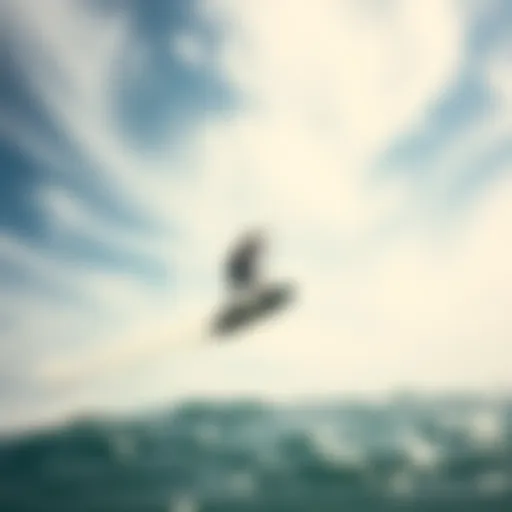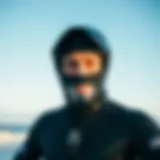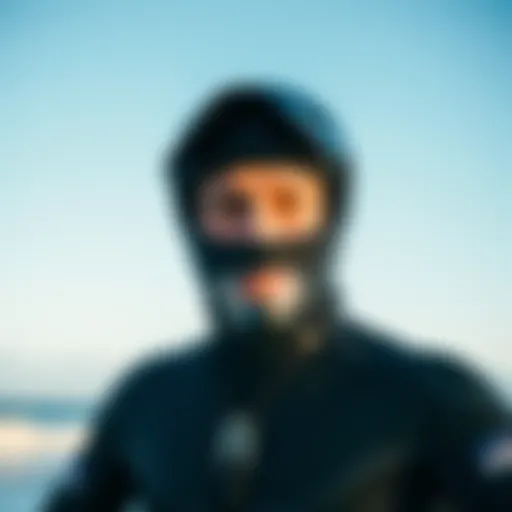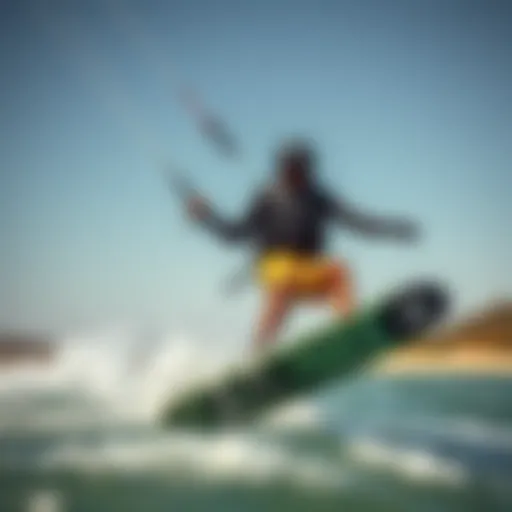The Complete Guide to Patagonia Wetsuits for Kiteboarding


Intro
Diving into the world of kiteboarding is like stepping onto a dynamic dance floor where the wind leads, and the water provides an exhilarating stage. Among the essential elements of a satisfying experience is the wetsuit, particularly when it comes to selecting the right one for kiteboarding. Patagonia, known for blending functionality with a commitment to the environment, offers a variety of wetsuits that cater to diverse needs.
This guide doesn't just skim the surface; it probes deep into Patagonia’s wetsuits, emphasizing their design philosophy, innovative technologies, and the overall impact on the kiteboarding lifestyle. For both novice and seasoned kiteboarders, understanding the nuances of wetsuit selection can greatly influence your performance and enjoyment on the water.
The subsequent sections will illuminate key gear insights and delve into techniques that enhance your kiteboarding experience while ensuring sustainability. By the end of this guide, readers will be equipped with the knowledge to make informed decisions about their wetsuit, which can translate into a more enjoyable and environmentally-conscious kiteboarding adventure.
Gear Insights
Latest Gear Reviews
Patagonia’s wetsuit range has garnered attention not only for their aesthetic appeal but also for their impressive performance. The R1 Lite Yulex Full Suit, for example, showcases Patagonia’s commitment to using natural rubber sourced from responsibly managed plantations. This product not only keeps the body warm in cooler waters but is also designed with sustainability in mind. Reviewers highlight its flexibility, making it ideal for those agile maneuvers often executed while kiteboarding.
Another standout is the Patagonia R3 Yulex Full Suit, which is thicker and offers superior insulation in colder climates. Users appreciate its durability and the comfort it provides during extended sessions on the water. Its eco-friendly construction means that riders can feel good about their equipment choices while enjoying the thrill of kiteboarding.
Essential Gear for Beginners
For those new to kiteboarding, selecting the right wetsuit can feel daunting. Here’s a quick rundown of essential gear to kickstart their journey:
- Thickness: A 3/2 mm wetsuit is often ideal for milder conditions, providing sufficient warmth without restricting movement.
- Fit: Ensure the wetsuit fits snugly but doesn’t constrict; this is crucial for comfort and flexibility.
- Entry Type: Consider whether a back zip or chest zip entry is preferred, as both have their pros and cons regarding ease of getting in and out.
- Material: Opt for Yulex or neoprene depending on the environmental impact considerations. Yulex is more sustainable, while neoprene is often lauded for its insulation properties.
As you embark on your kiteboarding journey, understanding these fundamental elements can prevent unnecessary discomfort, allowing you to focus more on riding the waves.
"Choosing gear that respects our planet isn’t just a trend; it's a responsibility. Standout brands like Patagonia lead the charge in sustainable practices, ensuring we can enjoy our passions without compromising the environment."
Prologue to Patagonia Wetsuits
When it comes to kiteboarding, many factors can have a significant impact on your overall experience out there on the water, and one of the most important is the wetsuit you choose. This section sheds light on the significance of Patagonia wetsuits specifically, given their reputation in the kiteboarding community.
Brand Overview
Patagonia is not just your average outdoor clothing company; it's a brand with a soul, a deep-seated commitment to environmental sustainability and performance. Founded in 1973, the company began as a climbing equipment maker before branching out into a broader spectrum of outdoor apparel. The ethos of Patagonia revolves around innovation—integrating eco-friendly practices with high-performance gear tailored for various sports, including kiteboarding.
The brand's dedication shines through in its wetsuit designs. Instead of leaning on conventional neoprene—which is derived from petroleum—Patagonia has pioneered the use of Yulex, a plant-based rubber alternative. This commitment to using sustainable materials not only appeals to environmentally conscious kiteboarders but also aligns with the needs for durability and flexibility required in action sports.
With the advent of more conscious consumerism in recent years, the brand's recognition has surged, making it a prominent choice among not only enthusiasts but also professionals in kiteboarding. Many riders rave about the unique blend of comfort, style, and functionality, making Patagonia a brand worth examining closely.
Evolution of Wetsuits
Wetsuits have come a long way since their inception in the mid-20th century. Initially made from simple rubber, these suits were more about keeping the cold at bay than optimizing performance. As sports like surfing and later kiteboarding gained popularity, wetsuit designs evolved to accommodate the specific demands of each activity.
Patagonia has played a key role in this evolution. In the beginning, if you bought a wetsuit, your options were limited by factors such as thermal retention and thickness. Fast forward a few decades, and the inclusion of technology means that today’s options come with an array of features.
The introduction of new materials, such as Yulex, revolutionized the market. This innovation not only provides better thermal properties but also represents an important step toward sustainability. Riders no longer need to compromise between performance and environmental responsibility.
"Patagonia's wetsuits stand as a testament to what the industry can achieve when it prioritizes the planet alongside performance."
In the modern context, the evolution of these suits reflects a deeper understanding of user needs and environmental impacts. Modern wetsuits offer improved insulation, flexibility, and comfort while ensuring that the planet we ride on is cared for. From this backdrop, understanding the technology and performance metrics of Patagonia wetsuits helps kiteboarders choose the right gear suited to their individual needs.
The Technology Behind Patagonia Wetsuits
When you’re kiteboarding, the right wetsuit is a game changer. The technology behind Patagonia wetsuits provides a mix of performance, comfort, and sustainability that can enhance any rider's experience. Understanding these technologies not only helps in making the right choice but also highlights the brand’s commitment to both quality and the environment.
Neoprene Alternatives
Patagonia has taken the road less traveled with their use of neoprene alternatives. Traditional neoprene, often derived from petroleum, has come under scrutiny for its environmental impact. In response, Patagonia offers Yulex, a natural rubber sourced from rubber trees. This alternative is a step forward because it reduces reliance on fossil fuels and decreases carbon footprint.
- Benefits of Yulex:
- Eco-Friendly: Since it's made from renewable resources, Yulex helps in the fight against climate change.
- Performance: Users have reported comparable flexibility and warmth to traditional neoprene, making it perfect for kiteboarding adventures.
- Durability: Yulex stands up well against wear and tear, so those who are constantly on the water aren't left high and dry.
Using renewable resources isn’t just a gimmick; it reflects a growing awareness in the outdoor apparel industry of how choices can affect our planet. Patagonia is leading the charge by making alternative wetsuits that keep the thrill of kiteboarding alive while caring for the Earth.
Thermal Regulation Features
Thermal regulation is no small potato when it comes to choosing the right wetsuit. Wet and cold conditions can sap the energy from even the most seasoned kiteboarder. Patagonia’s wetsuits are designed to trap warmth, ensuring that riders stay comfortable through chilly wind and water.
- Key Features:
- Fleece Interior: The cozy fleece lining retains body heat without weighing you down, allowing for agile movements.
- Smart Design: The hydrophobic outer layer helps to wick away moisture and prevent ice-cold water from getting in.
- Temperature Ratings: Different models are rated for specific temperatures, meaning you can find the right wetsuit for spring, summer, or the depths of winter.
This thermal regulation isn’t just a luxury; it's a necessity for kiteboarders who want to maximize their time on the water. A well-constructed wetsuit means longer sessions and less time shivering on the shore.
Seam Construction and Durability
The durability of a wetsuit goes hand in hand with its seam construction. Patagonia adheres to the highest standards, employing various techniques to ensure their wetsuits can take a beating. Kiteboarding often means crashes, wipes, and rough conditions, so a suit that can withstand this wear and tear is non-negotiable.


- Seam Techniques:
- Glued and Blind-Stitched Seams: This method prevents water from seeping through, keeping you dry and warm.
- Lined with Yulex: Using Yulex at the seams adds additional durability, meaning fewer repairs and longer usage.
- Strategic Placement: The seams are designed in a way that reduces chafing and irritation, which can be a real bummer during long rides.
Durability isn't just about how well a wetsuit can handle the rigors of kiteboarding; it's about ensuring that every zipping, diving, and rolling session is as comfortable as possible. Given the investment in quality gear, it’s comforting to know that Patagonia's attention to seam integrity leads to a wetsuit that thrives under pressure.
"Patagonia’s commitment to innovative design allows users to enjoy their kiteboarding experience without jeopardizing the planet's health."
Choosing Patagonia means selecting a gear that aligns with an environmentally conscious lifestyle while still offering top performance. As kiteboarding continues to grow, those who ride with intention will find that technology plays a crucial role in their adventures on the water.
Choosing the Right Patagonia Wetsuit
Selecting the appropriate wetsuit from Patagonia is fundamental for any kiteboarder. As this sport strongly depends on the balance between warmth, flexibility, and comfort, the right wetsuit can make all the difference in your performance on the water. It’s like wearing the right pair of shoes—choose wisely, and you're set to go; make a poor choice, and you could end up with a world of discomfort.
In this section, we will explore critical aspects, including fit and size considerations, thickness options, and how your intended use impacts your wetsuit choice. This information not only enhances your kiteboarding experience but also extends the lifespan of your investment.
Fit and Size Considerations
When it comes to wetsuits, fit is non-negotiable. A suit that’s too loose might let water in, which leads to discomfort and loss of body heat. Conversely, a suit that’s too tight can restrict movement and even impede your breathing, especially during intense kiteboarding sessions.
Patagonia provides a variety of sizing options tailored to different body shapes. It’s important to measure yourself accurately and consult Patagonia’s size chart to ensure the ideal fit.
Here are some tips for finding the right fit:
- Try it on: Always try the suit on before buying. Move around, jump, and stretch to ensure comfort.
- Check the seams: A well-fitted wetsuit will have seams lying flat and not pinching.
- Understand materials: Different materials offer varying stretches. Yulex, for instance, is eco-friendly and stretches well without sacrificing warmth.
Ultimately, investing time in finding the right fit can save you hassle in the long run as you hit the waves with confidence.
Thickness Options
The thickness of a wetsuit is a vital consideration as it correlates directly to the water temperature and the conditions you plan to ride in. Patagonia offers several thickness options to cater to different environments, ensuring you stay comfortable regardless of the chill.
Shorty Wetsuits
Shorty wetsuits typically feature short sleeves and legs, offering a balance between flexibility and some thermal protection. This style shines in warmer environments or during the hot summer months.
Key Characteristics:
- Lightweight and flexible: Perfect for warm weather kiteboarding.
- Ideal for summer: A great choice for tropical waters or mild climates.
Unique Features:
- Easy on/off: The design allows for ease of movement and quick changes.
Advantages/Disadvantages:
- Advantage: Keeps you cool while providing some protection from UV rays.
- Disadvantage: Might not provide enough warmth in cooler waters.
Full-Body Wetsuits
Full-body wetsuits, extending from neck to ankle, provide superior coverage and thermal insulation. They are favored for colder climates where body heat retention is crucial.
Key Characteristics:
- Thermal protection: Efficiently traps warmth, ideal for brisk kiteboarding.
- Versatile: Can be layered with additional thermal garments as needed.
Unique Features:
- Long sleeves and legs: Deliver full coverage against the elements.
Advantages/Disadvantages:
- Advantage: Best suited for a range of conditions, from cool seas to chilly winds.
- Disadvantage: Can be bulkier and less flexible compared to shorty wetsuits.
Cold-Water Variants
For those who adventure into frigid waters, cold-water variants are designed specifically to handle the chill while still offering enough mobility for dynamic kiteboarding moves.
Key Characteristics:
- Extra thick insulation: Typically found in 5mm or 6mm options providing maximum warmth.
- Enhanced seals: These suits often feature advanced seals to minimize water entry.
Unique Features:
- Windproof lining: Some suits include materials that minimize wind chill.
Advantages/Disadvantages:
- Advantage: Keeps you warm during extended sessions in cold conditions.
- Disadvantage: They can limit mobility slightly due to thickness.


Intended Use in Kiteboarding
Once you have considered fit and thickness, understanding your intended use in kiteboarding further refines your wetsuit choice. Depending on whether you are a casual rider or an advanced kiteboarding athlete, the specific demands on your wetsuit will vary.
- Beginner Riders: May prefer shorty wetsuits for balance and ease, as they are still mastering their board control.
- Casual Enthusiasts: Might find comfort in full-body suits that accommodate spontaneous trips.
- Advanced Riders: Often opt for cold-water variants or thicker suits to maintain optimal performance in extreme conditions.
By mindfully considering these factors, you ensure that your Patagonia wetsuit aligns perfectly with your kiteboarding ambitions, ultimately leading to better performance and a more enjoyable experience on the water.
Performance Review of Popular Patagonia Wetsuit Models
When it comes to kiteboarding, having the right wetsuit isn't just a luxury, it's a necessity. The performance of wetsuits can make or break your experience on the water. Several factors influence how well a wetsuit performs, including insulation, flexibility, and durability. In this section, we’ll dive deep into three notable models from Patagonia, each tailored for different conditions and rider needs. Understanding these differences is crucial for kiteboarders—whether you're just starting or looking to upgrade your gear.
R1 Lite Yulex Wetsuit
The R1 Lite Yulex Wetsuit is designed for warmer water, making it ideal for those sunny kiteboarding days when the wind is just right. Constructed from Yulex natural rubber, this wetsuit strikes a balance of warmth and breathability.
Benefits:
- Lightweight Feel: The R1 Lite is incredibly lightweight, allowing for ease of movement, which is essential for performing tricks.
- Eco-friendly Choice: Unlike conventional neoprene, Yulex is more environmentally sustainable, providing warmth without the guilt.
- Good Flexibility: The wetsuit offers a blend of enough stretch and support, so riders can feel comfortable without sacrificing performance.
The R1 Lite is a well-received option for those who plan to hit the water during the spring or summer months. It incorporates strategically placed panels that allow for maximum range of motion. However, some users mention it's not suitable for colder waters, which can limit its versatility.
R2 Yulex Wetsuit
Stepping up the warmth factor, the R2 Yulex Wetsuit caters to those chilly kiteboarding sessions. This model is thicker than the R1, designed to keep you cozy when the water temperature drops.
Considerations:
- Warmth: The R2 features strategic thermal lining to help retain body heat, making it a solid choice for autumn kiteboarding where temperatures can vary.
- Versatile Fit: It accommodates a broader range of body types, thanks to its multiple size options.
- Durability: With reinforced seams, this wetsuit is built to withstand the wear and tear of regular use, allowing for a seasoned rider to really put it through its paces.
While the R2 may feel bulkier than its lighter counterpart, many users appreciate its insulation features. It’s not just about warmth, but maintaining maneuverability in those colder waters too.
R3 Yulex Wetsuit
For the cold-water warriors, the R3 Yulex Wetsuit stands as a testament to Patagonia’s commitment to kiteboarders who brave the elements. This model is robust, offering the most insulation among the three.
Key Features:
- Thickest Construction: The R3 is designed specifically for frigid conditions, making it optimal for winter kiteboarding.
- Heat Retention: Enhancements such as built-in thermal panels work wonders in keeping the cold at bay, even when temperatures dip.
- Optimal Coverage: Its full-zip design allows for easy entry and exit while maintaining thermal integrity.
The R3 is recommended for riders willing to face harsh conditions. Riders appreciate the fit but note that finding the right size is vital to ensure it's not too restrictive during action.
"Choosing the right wetsuit model is as crucial as selecting the right board. Each model serves its own purpose based on the water temperature and individual preference."
Environmental Impact and Sustainability
In an age where environmental awareness is at the forefront, the significance of sustainability in the production and use of materials shines brightly. When it comes to Patagonia wetsuits, understanding environmental impact and their commitment to sustainability becomes more than just a discussion; it’s a way of life for many who cherish our oceans and shores. This section explores how Patagonia is not only designing top-tier wetsuits for kiteboarders but also actively working towards minimizing their ecological footprint.
The benefits of incorporating sustainability into product design extend well beyond the obvious. For kiteboarders, choosing wetsuits that support environmental health can lead to cleaner waters and healthier ecosystems. When riders make informed choices, it reflects their values towards conservation and responsibility. Moreover, a sustainable product often comes with higher quality and durability, ensuring it stands the test of time, thus reducing waste.
Sourcing Materials
Patagonia’s approach to sourcing materials is both thoughtful and innovative. In recent years, the brand has pivoted away from conventional neoprene, a material often criticized for its environmental toll. Instead, they have adopted Yulex, a natural rubber sourced from responsibly managed sources. This transition is critical, as Yulex not only reduces dependency on petroleum-based resources but also offers excellent performance, retaining flexibility and warmth for kiteboarders.
Efforts to ensure that the rubber is harvested sustainably involve collaborating with the Forest Stewardship Council—a body dedicated to promoting responsible forestry. By investing in these sustainable sources, Patagonia is committed to providing products that not only perform well but also prioritize the health of our planet.
Recycling Programs
Beyond sourcing, Patagonia actively promotes recycling, offering programs that allow users to return their used wetsuits for a second life. This initiative counters the traditional model of consumption, ensuring that these suits don’t end up in landfills when they have finished serving their purpose. Through programs like Worn Wear, customers can trade in old gear, which can be repaired, refurbished, and resold, solidifying a circular economy.
Adopting practices like this isn’t just a marketing gimmick; it’s a cultural shift within the kiteboarding community. Riders who participate in recycling programs contribute to a greater cause, fostering an ethos of care and respect for the environments where they enjoy their sport. This sustainable cycle leads to lesser resource extraction and minimized environmental impact, encouraging others to follow suit.
"Investing in sustainable practices is investing in the world we leave for the next generation of adventurers."
In closing, the environmental impact and sustainability of Patagonia wetsuits reflect a conscientious effort that aligns with the values of modern kiteboarders. Rather than just being a brand, Patagonia represents a commitment to preserving the very environments we cherish while enjoying the thrill of riding the waves.
Maintenance and Care for Patagonia Wetsuits
Taking care of your Patagonia wetsuit is crucial for ensuring its longevity and performance. Kiteboarding puts a wearsome demand on our gear, making regular maintenance vital. By following a few simple care steps, you can keep your wetsuit in tiptop shape, thus enhancing the overall experience on the water. From washing techniques to proper storage, every detail plays a part in extending the life of your investment.
Proper Washing Techniques
To keep your wetsuit clean and fresh, proper washing techniques are essential. After a frolick in the waves, rinse your wetsuit with fresh water to remove any salt, sand, or debris. Do this as soon as possible. Don't just toss it in the washer like an old t-shirt; there are nuances here that cannot be overlooked.
Here’s a simple breakdown of effective washing methods:
- Rinse with cold water: Use a gentle stream to wash off any leftover elements from your day on the water. This helps maintain the integrity of the material.
- Use wetsuit-specific detergent: If your suit needs a deeper clean, use a specially formulated detergent. Regular laundry detergent can be too harsh and may break down the neoprene.
- Hand wash: If you're willing to go the extra mile, hand washing is preferred. Fill a bathtub with cool water and a bit of your gentle detergent. Gently scrub your suit with lukewarm water and avoid wringing or twisting it, as this can damage the seams.
"A little care goes a long way. Your wetsuit is not just gear; it's your companion in adventure."


After washing, hang your wetsuit up to dry, preferably in a shaded area, away from direct sunlight, as prolonged exposure can cause fading and deterioration of materials over time.
Storage Recommendations
Proper storage is as important as cleaning your wetsuit. How you store it can significantly extend its life and performance. Here are a few useful pointers for storing your Patagonia wetsuit:
- Avoid folding: Instead of folding your wetsuit, roll it up gently from the feet. This minimizes creasing and potential damage to the material.
- Use a proper hanger: Invest in a wide, padded hanger specifically made for wetsuits. Hang it in a cool, dry place where it won't be squished by other gear.
- Store in a cool, dark place: Ensure your wetsuit is kept away from extreme temperatures and direct sunlight. A closet or storage bin works wonders. Just make sure it's well ventilated.
- Inspect Regularly: Make it a habit to check your wetsuit for any signs of wear or damage during storage. Small issues, like pinhole punctures or loose seams, can worsen if not addressed quickly.
Taking these maintenance steps not only helps in keeping your wetsuit ready for action but also proves beneficial for the environment, as a well-maintained suit reduces waste over time. With the right care, you can enjoy your adventures in kiteboarding without worries about your gear.
User Experiences and Testimonials
When diving into the world of Patagonia wetsuits, one can't overlook the weight that user experiences and testimonials carry. These insights are not mere anecdotes; they are real-life accounts that provide a window into how these products perform under various conditions. For kiteboarders, understanding what others think can significantly inform their purchase decisions, ensuring that they choose a wetsuit that fits not only their body but also their riding style and environmental conditions.
The benefits of gathering user experiences include:
- Diverse Perspectives: Testimonials from both beginners and seasoned riders outline the wetsuits' adaptability and performance in various waters, from tranquil lakes to raging ocean swells.
- Practical Insights: Users often highlight specific features they found helpful, such as ease of movement, warmth retention, or durability during rough sessions, which can be crucial for someone trying to decide on a product.
- Community Building: Sharing experiences creates a sense of camaraderie among kiteboarders, fostering an environment where riders support each other through shared knowledge and resources.
Overall, these narratives greatly enhance an informed choice for prospective buyers, shedding light on what they can genuinely expect from Patagonia wetsuits.
Beginner Kiteboarders' Insights
For newcomers to kiteboarding, navigating the vast selection of wetsuits can feel a bit overwhelming. Here, insights from beginner kiteboarders can be golden. Many first-timers have shared that comfort is paramount, especially when learning how to balance on the board and maneuver through the waves. They emphasize the importance of a wetsuit that allows for ample flexibility, making movements natural and unencumbered.
One common takeaway from these beginners is the role warmth plays in the overall experience. They quickly learned that a good wetsuit keeps them comfortable even when the water feels icy. For instance, riders have mentioned their appreciation for the Yulex material in Patagonia wetsuits, claiming it provides a pleasant layer against the chill, which allows them to focus on improving their skills rather than shivering through their sessions.
Moreover, first-time users often talk about the fit of the wetsuit. A snug fit is essential; however, they also caution against going too tight. As one rider put it, "It's all about finding that balance—you want it tight, but not so tight you can’t breathe or move!" This insight addresses the importance of trying on different sizes and cuts before making a purchase, even if it means visiting a store.
Advanced Rider Perspectives
On the flip side, advanced kiteboarders bring a wealth of experience that shapes their expectations from Patagonia wetsuits. These riders tend to focus on specific performance aspects. Many advanced users highlight the importance of durability, often recalling instances where their wetsuits endured countless sessions without showing signs of wear.
Performance features are frequently mentioned in their testimonials. For instance, a number of advanced riders praise the seamless construction of their Patagonia suits, stating that this design not only enhances comfort but also improves heat retention while minimizing chafing during extended rides. One noted, "I can stay out for hours without feeling that dreaded discomfort in my neck or armpits!"
Finally, environmental consciousness resonates deeply with this group. Advanced riders often feel a strong connection to Patagonia’s commitment to eco-friendliness. They express appreciation for the company’s dedication to sustainability, stating that it gives them peace of mind while enjoying their adventure. This combination of functionality and ethical practice truly resonates with their riding philosophy.
In essence, while beginner kiteboarders seek comfort and flexibility, advanced riders tend to gravitate towards durability and performance features. Both perspectives provide a comprehensive understanding of Patagonia wetsuits, validating their relevance in the kiteboarding community.
Comparing Patagonia Wetsuits with Competitors
When it comes to selecting the right wetsuit, the landscape is vast, and brands are aplenty. In this section, we dig deep into how Patagonia stacks up against its competitors in the market. This is crucial for kiteboarders, whether you’re just starting out or have spent years carving through the waves. The right wetsuit can make or break your experience on the water. By understanding the nuances of Patagonia's offerings in comparison to other brands, riders can make informed decisions that suit their specific needs and preferences.
Key Differentiators
Patagonia wetsuits are often touted for their commitment to sustainability and performance. Here are some standout features that set them apart from other brands:
- Eco-Friendly Materials: Patagonia’s use of Yulex, a latex alternative sourced from rubber trees, distinguishes it noticeably in an industry where traditional neoprene reigns.
- Sustainable Production Practices: They adhere to strict environmental standards, ensuring that their production methods do not harm the planet. This makes their suits not just high-performing but also more appealing to eco-conscious riders.
- Design and Fit: Their wetsuits are designed with an emphasis on comfort and movement. This attention to detail can often result in a more fluid experience on the water, which is especially vital when kiteboarding.
- Durability: Patagonia's focus on quality construction means their suits tend to last longer, making them a worthwhile investment over time compared to some other brands that may skimp on stitching and materials.
"Choosing Patagonia is not just about getting a high-performance wetsuit; it’s a commitment to choosing a brand that values the planet as much as you do."
Price Point Analysis
Patagonia wetsuits generally come at a higher price point than many competitors. This can raise eyebrows, especially for kiteboarders looking to maximize their budget. However, it is essential to look beyond the sticker price:
- Value for Quality: The investment in Patagonia’s higher-priced suits often translates into better materials and longer-lasting products. This can mean fewer replacements over time.
- Cost vs. Sustainability: Many riders are willing to pay extra for eco-friendly options, making Patagonia's offering attractive for those willing to prioritize the planet over a few extra bucks.
- Competitive Landscape: While brands like O'Neill or Rip Curl may offer lower-priced wetsuits, scrutinizing their sustainability initiatives or the performance of their materials may leave some feeling it’s not worth the trade-off.
- Long-Term Savings: Folks often forget that a more expensive wetsuit can save money in the long run. When a suit lasts several seasons, it can easily justify the initial investment.
In summary, while Patagonia wetsuits may cost more upfront, the benefits can outweigh the initial investment for many kiteboarders. The right choice boils down to the individual rider’s values and priorities, balancing performance, ethical production, and budget.
The End and Recommendations
In summarizing our exploration of Patagonia wetsuits, it becomes clear that these suits encapsulate more than just straightforward waterproof gear for kiteboarding enthusiasts. The combination of innovative technology, a robust commitment to sustainability, and a user-centered design philosophy position Patagonia as a prominent player in the kiteboarding space.
Patagonia’s dedication to eco-friendly practices and materials means that riders can feel good about their gear choice, knowing that they are supporting a brand that prioritizes the health of our oceans and the planet. This level of conscientiousness is becoming increasingly relevant in our modern world where responsible consumerism is much appreciated.
When it comes to selecting the right wetsuit, consideration of fit and intended use is paramount. A good wetsuit should feel like a second skin, allowing for full range of motion without feeling restrictive. Factors such as warmth retention and buoyancy can significantly enhance one’s experience on the water, thus it’s essential to choose a suit that aligns with local water conditions and personal preferences.
Ultimately, Patagonia wetsuits stand out because of their durability and performance. They shine not just in favorable conditions but also prove reliable when the weather turns sour. Investing in a high-quality Patagonia wetsuit equals investing in countless exhilarating kiteboarding sessions ahead.
"A suit that fits well and is made from sustainable materials not only enhances your experience but contributes to a better future for the waters we love."
Final Thoughts on the Brand
Patagonia has long been synonymous with outdoor adventure, and their wetsuits are no exception to this legacy. The brand masterfully transforms technical innovation into gear that end users trust. From using Yulex, a plant-based material, instead of traditional neoprene to impeccable attention to detail in construction, every aspect resonates with a drive for excellence. Consumers looking for more than just performance need to consider the ethos of Patagonia, which promotes not only personal enjoyment in kiteboarding but also a broader environmental stewardship.
The brand’s rich history, commitment to sustainability, and exceptional customer service reinforce their position as a leader in the industry. Additionally, their transparent approach about sourcing and product lifecycle builds confidence in both novice and seasoned kiteboarders alike.
Best Picks for Kiteboarding
To wrap it all up, let’s look at some of the top Patagonia wetsuit choices for kiteboarding:
- R1 Lite Yulex Wetsuit: Best for warmer weather, this suit provides ample flexibility while retaining necessary warmth.
- R2 Yulex Wetsuit: A good option for cooler days, offering a balanced thickness that suits varying conditions well.
- R3 Yulex Wetsuit: For those frosty water escapades, this is the go-to wetsuit. It combines warmth with sustainability.
It’s worth making a choice based on water temperature, personal comfort, and style preferences. Each model excels in its domain, making it easier for kiteboarders to find a wetsuit that caters to their specific needs.
In internet discussions, many riders praise Patagonia’s durability and comfort, often citing how their suits remain reliable over countless rides. Engaging with user forums on platforms like Reddit can provide additional insight into real-world experiences, allowing potential buyers to make informed decisions.















